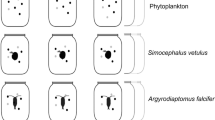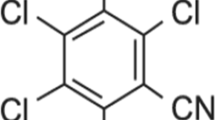Abstract
A Zooplankton community was established in out-door concrete ponds to which an insecticide, carbaryl (0.5 mg/L final concentration), was applied at different times relative to the population trend. The chemical application markedly reduced the cladoceran and copepod populations, but not rotifer population. After the treatments,Bosmina fatalis recovered earlier thanDaphnia spp. and was predominant until recovery of theDaphnia. The reappearance ofDaphnia was gradually delayed when the treatment was carried out at later times. Thus, the treatment induced the predominance ofBosmina, and the period whenBosmina predominated was extended when the carbaryl applications were delayed. The recovery ofDaphnia was probably retarded by the decline in water temperature, which decreased steadily during most of the experimental period. When carbaryl was applied during the increasing phase of theKeratella valga population, the population increased still further in density. When the population was exposed to the chemical during its decreasing phase, it did not recover even when competitors disappeared. Thus, applications of the insecticide at different times induced different recovery patterns of the Zooplankton community in the ponds.
Similar content being viewed by others
References
Bhajan WR, Hynes HB (1972) Experimental study on the ecology ofBosmina longirostris (O. F. Müller) (Cladocera). Crustaceana 23:133–140
Brooks JL, Dodson SI (1965) Predation, body size, and the composition of plankton. Science 150:28–35
Butcher JE, Boyer MG, Fowle CD (1977) Some changes in pond chemistry and photosynthetic activity following treatment with increasing concentrations of chlorpyrifos. Bull Environ Contam Toxicol 17:752–758
Day KE, Kaushik NK, Solomon KR (1987) Impact of fenvalerate on enclosed freshwater planktonic communities and onin situ rates of filtration of Zooplankton. Can J Fish Aquat Sci 44:1714–1728
Gerritsen J (1984) Size efficiency reconsidered: A general foraging model for free-swimming aquatic animals. Am Nat 123:450–467
Hall DJ, Threlkeld ST, Burns CW, Crowley PH (1976) The size-efficiency hypothesis and the size structure of zooplankton communities. Annu Rev Ecol Syst 7:177–208
Hanazato T, Yasuno M (1985) Effect of temperature in the laboratory studies on growth, egg development and first parturition of five species of Cladocera. Jpn J Limnol 46:185–191
— — (1987) Effects of a carbamate insecticide, carbaryl, on the summer phyto- and Zooplankton communities in ponds. Environ Pollut 48:145–159
- -(1988a) Effects of carbaryl on the spring Zooplankton communities in ponds. Environ Pollut (in press)
- -(1988b) Impact of predation ofNeomysis intermedia on a Zooplankton community in Lake Kasumigaura. Verb Internat Verein Limnol (in press)
Haney JF, Hall DJ (1973) Sugar-coatedDaphnia: A preservation technique for Cladocera. Limnol Oceanogr 18:331–333
Helgen JC, Larson NJ, Anderson RL (1988) Responses of zooplankton andChaoborus to temephos in a natural pond and in the laboratory. Arch Environ Contam Toxicol 17:459–471
Hughes DN, Boyer MG, Papst MH, Fowle CD, Rees GAV, Baulu P (1980) Persistence of three organophosphorus insecticides in artificial ponds and some biological implications. Arch Environ Contam Toxicol 9:269–279
Huribert SH, Mulla MS, Willson HR (1972) Effects of an organophosphorus insecticide on the phytoplankton, Zooplankton, and insect populations of fresh-water ponds. Ecol Monogr 42:269–299
Kaushik NK, Stephenson GL, Solomon KR, Day KE (1985) Impact of permethrin on Zooplankton communities in limnocorals. Can J Fish Aquat Sci 42:77–85
Papst MH, Boyer MG (1980) Effects of two organophosphorus insecticides on the chlorophylla and pheopigment concentrations of standing ponds. Hydrobiologia 69:245–250
Threlkeld ST (1976) Starvation and the size structure of zooplankton communities. Freshwat Biol 6:489–496
Vollenweider RA (1974) A manual on methods for measuring primary production in aquatic environments. IBP Handbook 12: 255pp. Blackwell Sci Publ, Oxford
Yasuno M, Hanazato T, Miyashita M (1986) Effects of chlornitrofen and temephos on an enclosure ecosystem in a pond. Res Rep Inst Environ Stud 99:107–118. (in Japanese; English abstract)
—, —, Iwakuma T, Takamura K, Ueno R, Takamura N (1988) Effects of permethrin on phytoplankton and Zooplankton in an enclosure ecosystem in a pond. Hydrobiologia 159:247–258
Zieris F-J, Feind D, Huber W (1988) Long-term effects of 4-Nitrophenol in an outdoor synthetic aquatic ecosystem. Arch Environ Contam Toxicol 17:165–175
Author information
Authors and Affiliations
Rights and permissions
About this article
Cite this article
Hanazato, T., Yasuno, M. Influence of time of application of an insecticide on recovery patterns of a zooplankton community in experimental ponds. Arch. Environ. Contam. Toxicol. 19, 77–83 (1990). https://doi.org/10.1007/BF01059815
Received:
Revised:
Issue Date:
DOI: https://doi.org/10.1007/BF01059815




